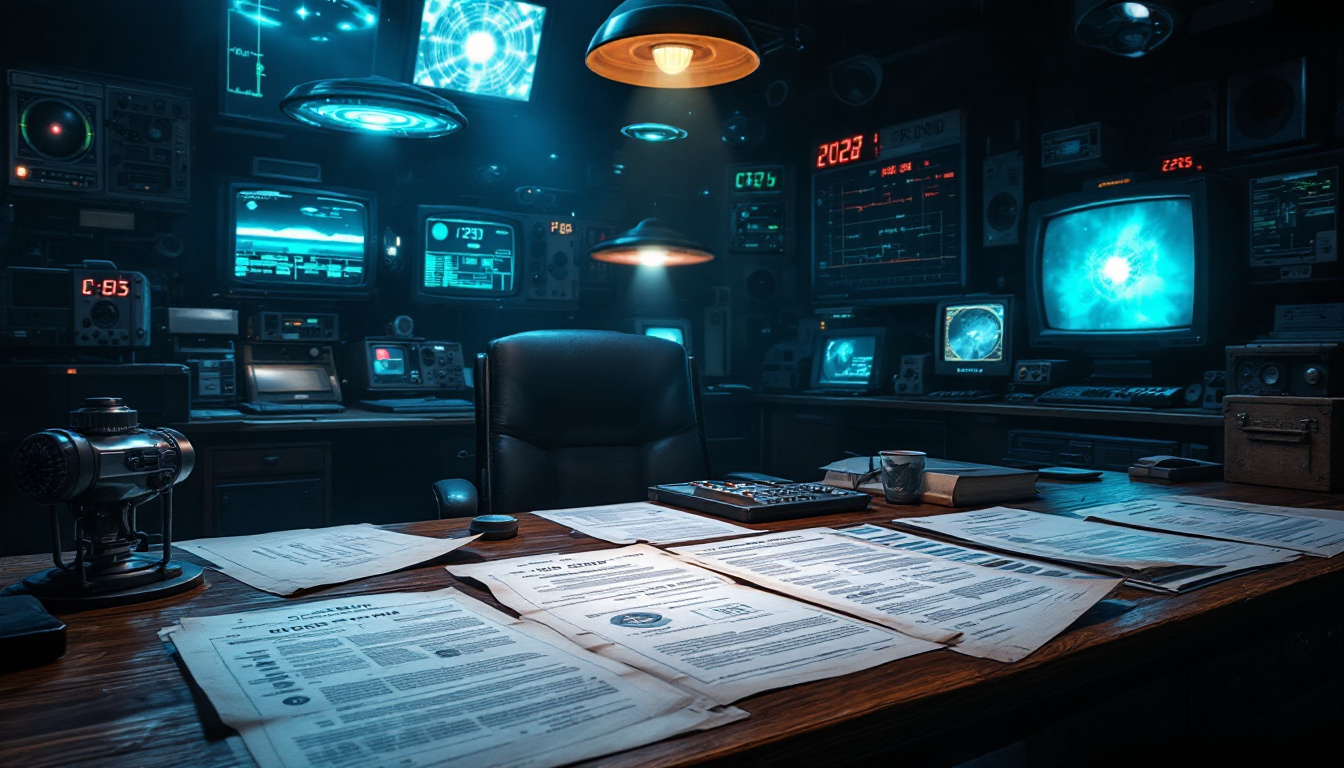Declassified CIA files have brought new clarity to Soviet military encounters with unidentified flying objects. For IT professionals, developers, engineers, and business leaders, these reports offer a practical study in how intelligence, security, and technology often intersect. The documentation shows a pattern of military clashes tied to unexplained aerial phenomena—events that demanded technical assessments, security responses, and policy reactions “Declassified CIA Files UFO”.
This summary provides a step-by-step outline of key incidents, extracted from official files. Readers will gain insight into how these cases impacted both military operations and the development of surveillance and detection systems, offering lessons that still influence modern technology and national security thinking.
Background: Intelligence Agencies, the Cold War, and the UFO Phenomenon
During the Cold War, two global powers stood divided by ideology, technology, and military ambition. The atmosphere was tense, characterized by a constant push for technological superiority and strategic advantage. Within this environment, intelligence agencies like the CIA and the Soviet KGB became central to monitoring possible threats, including unidentified flying objects. Encounters with unknown aerial phenomena were not only mysteries to solve but potential indicators of foreign espionage or breakthroughs in rival military technology.
The collection, analysis, and sharing of intelligence were crucial for both sides. The stakes were high—misinterpretation of a UFO event could escalate to military action or affect major policy decisions. As files have been declassified, it has become clear how closely UFO reports were tied to security priorities, technological innovation, and intelligence protocols.
Early Reports and Initial Encounters
The first Soviet military encounters with unidentified flying objects, as documented in declassified CIA files, often surfaced during heightened periods of weapons development and surveillance. Reports described craft with high maneuverability, unconventional lights, and speeds that exceeded known aircraft capabilities of the time.
Key characteristics repeatedly emerged in these initial accounts:
- Sudden appearance and rapid movement, sometimes over restricted or sensitive military zones.
- Radar confirmation alongside visual sightings, which made reports harder to dismiss as simple misperception or natural phenomena.
- Periodic loss of communication and brief technological disruptions experienced by military crews during encounters.
Intelligence agencies responded by launching comprehensive evaluation procedures. The Soviet military would compile incident details—location, time, flight patterns, and technical instrument readings—into structured reports. These would then be shared with scientific and intelligence branches for further analysis.
Simultaneously, the CIA collected and reviewed these Soviet accounts, comparing them with NATO observations and other allied intelligence. Each event prompted rigorous internal debate over origins, with some analysts pushing for exotic explanations and others arguing for secret adversary technologies or phenomena such as weather balloons. For more context on aerial surveillance and how it influenced Cold War relations, see Weather balloons and UFOs: FSU professor offers historical perspective on aerial surveillance.
CIA Analysis and Intelligence Sharing
The CIA’s evaluation of Soviet UFO reports reflected a structured and technical approach. Analysts prioritized the possibility that sightings might signal undetected advances in aerospace technology—either human or otherwise.
Their process included:
- Data Correlation: Cross-referencing Soviet accounts with US and allied signals intelligence to identify overlap and eliminate duplications.
- Pattern Recognition: Studying incident timing, geography, and reported maneuvers to filter routine activity from truly unexplained cases.
- Technical Assessment: Engaging engineers and flight specialists to analyze radar and sensor data, focusing on potential misidentification of classified aircraft or technological anomalies.
A recurring CIA concern revolved around distinguishing genuine unknowns from misperceived tests of advanced aircraft, such as reconnaissance planes or early drones. Notably, US intelligence realized that their own secret projects sometimes contributed to global spikes in UFO reports, a fact substantiated in a recent Pentagon report.
When significant, intelligence was shared with key allies through controlled channels—mirroring today’s cybersecurity intelligence protocols, which rely on timely exchange and analysis of threat data. Agencies sought a balance: careful dissemination supported preparedness while preventing information leaks that might expose operational capabilities.
The Soviet approach showed parallels, as seen in media reporting a multitude of UFO sightings, often with immediate routing to specialized units for follow-up. In rare cases, when physical evidence or observable effects were present, more intensive scientific investigation was ordered, sometimes involving research institutions cloaked in secrecy, as suggested in KGB reports on UFO incidents.
The gravity placed on these encounters reflected not just a search for extraterrestrial explanations, but a deep concern about surprise technological advances amid a tense global standoff. This environment encouraged a methodical, evidence-driven approach to intelligence gathering—practices that continue to influence modern security analysis across sectors today.
 Photo by cottonbro studio
Photo by cottonbro studio
Major Declassified Incidents: A Timeline of Soviet Military UFO Clashes
As Cold War tensions sharpened, Soviet military encounters with unidentified flying objects rose in frequency and seriousness—driving new responses from both armed forces and scientific circles. The progression from curiosity to confrontation shaped Soviet defense doctrine, technical research, and even policy debates. This section examines the most influential incidents documented in declassified CIA files, arranged by decade to illustrate shifting strategies and consequences.
The 1960s: Heightened Encounters and Technical Curiosity
 Photo by Derpy CG
Photo by Derpy CG
During the 1960s, the Soviet Union noted a series of unexplained aerial incidents near military sites and testing areas. The military’s reports—often confirmed by both radar and visual sightings—frequently described objects maneuvering in ways that appeared to defy existing aeronautical understanding.
Key characteristics and developments included:
- High-speed aerial maneuvers: Objects would accelerate or change direction in ways Soviet pilots could not replicate.
- Proximity to sensitive infrastructure: Reports often came from nuclear missile bases, air defense sites, or research facilities.
- Technical recoveries: Soviet investigators collected fragments and attempted back-engineering, seeking to understand possible propulsion or materials technology.
- Scientific inquiry initiated: Concern over repeated incidents prompted collaboration between military intelligence and Soviet scientific academies, moving the conversation from dismissal to systematic study.
The credibility given to these reports led to the establishment of classified working groups. These panels, which pooled engineers, physicists, and intelligence analysts, documented each case and compared notes with allied and adversary activities. The drive for technical advantage was clear—if any feature of the observed craft could be replicated, Soviet forces hoped to close potential gaps in aerospace technology.
For further historical context on Russia’s long history of unexplained sightings, see UFO sightings in Russia.
The 1970s-1980s: Escalating Clashes and Political Ramifications
By the late 1970s and into the 1980s, tensions peaked as Cold War paranoia intensified. Soviet air defense units recorded encounters with unidentified craft flying near strategic borders or even deep within restricted airspace. Several well-documented incidents shifted from passive observation to active military engagement.
These decades witnessed:
- Aircraft interceptions: Fighter jets frequently diverted to shadow or intercept unidentified targets, sometimes reporting loss of control or temporary avionics failure.
- Unexplained aerial maneuvers: Some objects reportedly performed right-angle turns or rapid ascents, surpassing what was feasible for conventional jets.
- Military exercise disruptions: Large-scale drills were interrupted or rerouted due to presence of unexplained objects, leading to classified assessments and internal security alerts.
Political consequences also became obvious:
- Classification and secrecy: Files related to these encounters carried the highest security designations, with only senior officers and special scientists given access.
- Secret scientific conferences: Small, invitation-only gatherings brought together government experts to debate the nature and origin of the phenomena—balancing fears of Western technological breakthroughs against true unknowns.
- Information containment: The Soviet leadership monitored both public and internal discourse, fearing panic or unintended disclosures to rivals.
Amid these responses, military protocol was updated to include special reporting guidelines. New radar and detection systems were rolled out, shaped by data drawn from unidentified object encounters.
For a broader look at how UFO reports factored into global Cold War politics, review The Cold War and UFOs.
Investigating these timelines highlights not only the Soviet focus on threat detection and technical parity, but also the role these unknown encounters played in shaping both military and scientific cultures behind the Iron Curtain. These cases continue to provide reference points for modern intelligence and security protocols, inspiring a mix of caution and innovation in response to aerial unknowns. To explore similar case studies in unexplained phenomena with military and national security consequences, visit unknown objects and their origins.
Implications and Lessons for the Modern Digital and Defense Landscape
The review of declassified Soviet UFO encounters sheds light on how high-stakes incidents shape policy, process, and progress—not only for military strategy but for today’s digital and security professionals as well. Patterns found in how the Soviet military managed unknown threats and guarded sensitive data have close parallels in modern cybersecurity and defense work. At the same time, the drive to understand mysterious technology ignited new pathways for innovation that still echo across the industries focused on intelligence and engineering.
Security Protocols and Information Management in High-Stakes Environments
 Photo by Ilya Sobolev
Photo by Ilya Sobolev
The Soviet military’s approach to UFO incidents reveals a disciplined framework for incident reporting and classified data handling. Immediate notification, strict documentation, and limited dissemination formed the core of their response. When a credible unknown threat emerged, standardized routines dictated how, when, and to whom information moved within the hierarchy. This rapid, controlled process resembles today’s best practices for cybersecurity incident response.
Key routines included:
- Prompt escalation: Reports of unknown threats received immediate review, ensuring rapid awareness at multiple security tiers.
- Chain-of-custody protocols: Every piece of evidence—whether radar logs or hardware fragments—underwent tracking and restricted access.
- Controlled information sharing: Sensitive details only traveled between vetted parties, balancing transparency with operational secrecy.
Modern cybersecurity teams find similar value in these strategies. For example, structured incident management processes help organizations maintain control over digital breaches and minimize data exposure. Roles, communication lines, and manual recordkeeping have been replaced with automated alerts, SIEM tools, and zero-trust networks, but the philosophy stays constant: clarity, discipline, and restricted access underlie all strong security postures.
Historical lessons from the Soviet era support the need for:
- Clear instructions for staff on how to report abnormalities.
- Defined risk assessment methods, separating routine “noise” from critical events.
- Strict internal controls over who can view or act on sensitive data.
Adopting these principles means being ready for both digital and physical disruptions—building a foundation that applies just as well to ransomware as to aerospace threats, as outlined in strategies for incident response and crisis management.
Technological Curiosity, Reverse Engineering, and Innovation
Soviet investigations into unidentified phenomena moved rapidly beyond mere observation. Technical teams focused on capturing and assessing every recoverable artifact or signature, asking whether observed technology could advance their own capabilities. This pressure to “decode the unknown” led to multi-disciplinary research groups and—where possible—direct attempts at reverse engineering.
Such innovation under uncertainty is a lesson for today:
- Data-driven analysis: Every encounter became a case study, and cross-domain collaboration brought together physicists, engineers, and security experts.
- Innovation out of necessity: Even when evidence was sparse, the hint of new propulsion, avionics, or materials technology drove attempts to replicate potential breakthroughs.
- Structured experimentation: Researchers evaluated results in controlled environments, producing not just theories but actionable prototypes and systems.
This climate of inquiry set a precedent that now shapes the technology sector’s response to new threats and opportunities. The willingness to experiment with emerging intelligence—whether a cyber-attack vector, disruptive AI, or novel sensor data—fuels progress across industries. Today’s business leaders and IT professionals benefit from robust frameworks for research and development, rigorous hypothesis testing, and openness to multi-disciplinary solutions.
While mystery propelled Soviet-era research, modern innovation often comes from competitive pressure and rapid technological change. Both cases reinforce the principle: novel challenges demand structured curiosity and a systematic approach to learning from the unknown. For real-world case studies in how governments and enterprises nurture innovation even from ambiguous sources, review how reverse engineering and technical intelligence shape advancements.
This section traces the lessons of Soviet military responses to UFOs into the core of present-day digital and security best practice. Both incident management and technical curiosity stand as pillars of preparedness and progress in sectors shaped by risk, secrecy, and constant technological evolution.
Conclusion
A review of the declassified CIA files on Soviet military clashes with unidentified flying objects shows clear patterns in both intelligence management and technical curiosity. The Soviet response—fast reporting, strict data control, and focused investigation—mirrored processes that IT and security teams rely on today. These historical incidents continue to shape how organizations see unknown risks and handle information under pressure.
The drive to study and sometimes reverse engineer unknown technology has influenced methods across defense and technology sectors. Maintaining a disciplined, investigative mindset remains essential for responding to the unexpected, whether it relates to cyber threats or emerging physical technologies.
IT and business leaders can draw from these lessons by fostering structured reporting, open technical inquiry, and strong data practices within their own teams. For those interested in how structured encounters with the unknown prepare organizations for the future, deeper analysis can be found in the impact of unidentified aerial phenomena on intelligence best practices.
Thank you for reading. Readers are encouraged to reflect on these insights and consider how a balanced, evidence-driven approach can support both security and innovation.









